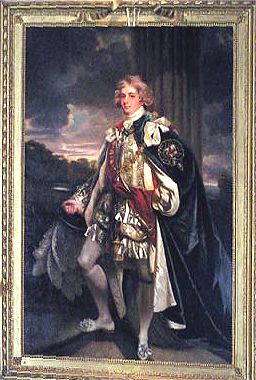 |
John Hoppner SN 394, oil on canvas, 1792, 1796, 1807 From: "The Pages" ARTIST: He entered the Royal Academy Schools in 1775. In 1781 he married Phoebe Wright, the daughter of an American sculptor (in whose salon many important contacts were made). This marriage resulted in the termination of his royal allowance, so he began to support himself by painting works suitable for engraving: fancy pictures & pretty women. He was soon painting increasingly distinguished sitters & by 1787 was well-established as the prime successor to Reynolds & Gainsborough. He became principal painter to the Prince of Wales (who became George IV, ruling from 1820-1830). |
Hoppner was an inveterate local traveler, and only once went abroad – to Paris, during the Peace of Amiens. He was known for his sharp wit – and horrible temper. By 1795 his health was deteriorating, and he died in London in 1810.
SUBJECT:
This is a state portrait of George IV, at the time he was the Prince of Wales. He is shown full-length, against an outdoor setting. His outfit is spectacular: he carries a plumed hat, wears silk hose with garters, & his shoes are adorned with rosettes. Bows and an elaborate Order are displayed on his long velvet cloak. Other jeweled Orders are prominent against his chest, and the hilt of a sword peeks out from his draperies. He is standing on a carpet.
PAINTING:
Hoppner’s portraits are known for their gorgeous color and good likenesses. The faces of his sitters are almost anatomically and structurally built up with paint, while his treatment of costume indicates a similar appreciation and understanding of the texture of each fabric. His brushwork is vibrant, as is his use of luscious color. As an advocate of the colore faction of Academic dispute, his neglect of draftsmanship was not unintentional.
His landscape backgrounds are often painted with an almost abstract vigor that looks forward to the work of Turner. (In fact, he was instrumental in advising Turner at the start of the latter’s career.)